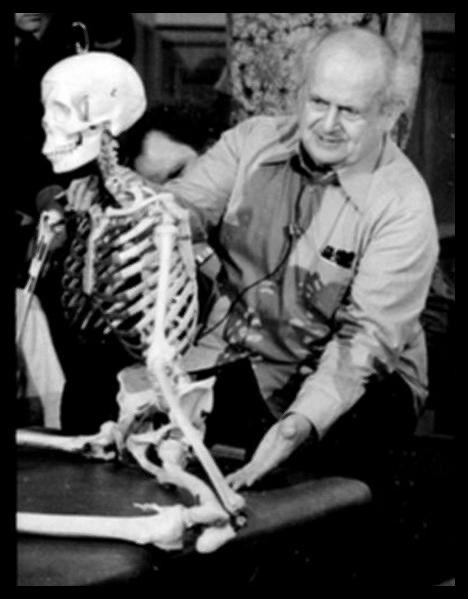Dr. Moshe Pinchas Feldenkrais Brief Biography
The Feldenkrais Method was developed by Dr Moshe Pinchas Feldenkrais ( 1904-1984) , an Israeli engineer, martial artist who suffered from a serious knee injury when playing soccer. When his doctors advised him that surgery might not allow him to walk normally, he searched for solutions to his physical ailment. While doing so, he blended his expertise in Jui Jitsui combined with his scientific curiosity and sensibility to help people learn to reorganize their movement, create more options to fulfill their dreams and aspirations. This synopsis of his life can not possibly do him justice. He was a brilliant man with so many facets but for those who do not know of him, it is a brief encounter to man who has left an indelible mark on so many during his life and many more who never had the good fortune to meet him.
Feldenkrais was born in the village of Slavuta, now considered the Ukraine on May 6 1906. but he grew up in Baranovich in what is, today, Belarus. His youth was a patchwork of pogroms and wars. He endured through World War I. He not only grew up in Jewish household where the study of Torah and the Talmud were part of Jewish education, but his ancestors were prominent scholars in Kabbalah, a more mystical tradition revolving around the Zohar. Their religious view is that God is a dynamic process of continuous creation that is manifest in ourselves. The four worlds of Kabbalah are emanation, creation, formation and action and “change anywhere is a change everywhere.” (1) His religious background clearly impacted his own philosophies of the Feldenkrais Method whether consciously or unconsciously. This idea of one affecting the other is echoed in Feldenkrais’ teaching which revolve around how we move but can also be mirrored in our feeling, thinking and sensing, each effecting the other. Also, this idea of a continuous process of creation is reflected in Feldenkrais principal that “Asking “How?” leads to discovering process, the keystone of the Feldenkrais Method.”
At the tender age of fourteen, in 1918, Feldenkrais left by himself on a six-month journey to Palestine. Once in Israel, , Feldenkrais worked as a laborer until 1923 and he joined the Haganna in 1920.. Due to numerous casualities among his friends defending themselves against arab attack, Feldenkrais developed hi own strategy for self defense. He returned to high school to earn a diploma and made a living by tutoring. After graduating in 1925, he worked for the British survey office as a cartographer. Feldenkrais was involved in Jewish self-defense groups, and after learning Jujitsu he devised his own self-defense techniques. He hurt his left knee in a soccer match in 1929. . While convalescing he wrote Autosuggestion (1930), a translation from English to Hebrew of Charles Brooks' work on Émile Coué's system of autosuggestion, together with two chapters that he wrote himself. Soon thereafter, he published Jujitsu (1931), a book on self-defense.
In 1930 Feldenkrai enrolled in an engineering college in Paris, specializing in mechanical and electrical engineering. It was also during this time that he met Jigaro Kano, Judo's founder, Feldenkrais began teaching Jujitsu again, and started his training in Judo. In 1933 he began working as a research assistant under Frédéric Joliot-Curie at the Radium Institute, while studying for his Ingénieur-Docteur degree at the Sorbonne. From 1935-1937 he worked at the Arcueil-Cachan laboratories building a Van de Graaf generator, which was used for atomic fission experiments. In 1935 he published a revised, French edition of his Hebrew jujitsu book called, La défense du faible contre l'agresseur, and in 1938 published ABC du Judo. He received his Judo black belt in 1936, and 2nd degree rank in 1938. Feldenkrais married Yona Rubenstein in 1938. From 1939-1940 he worked under Paul Langevin doing research on magnetics and ultra-sound.
Feldenkrais escaped to England in 1940, just as the Germans arrived in Paris. As a scientific officer in the British Admiralty, he conducted anti-submarine research in Scotland from 1940-1945. While there he taught Judo and self-defense classes. In 1942 he published a self- defense manual, Practical Unarmed Combat, and Judo. Feldenkrais began working with himself to deal with knee troubles that had recurred during his escape from France, and while walking on submarine decks. Feldenkrais gave a series of lectures about his new ideas, began to teach experimental classes, and work privately with some colleagues.
In 1946 Feldenkrais left the Admiralty, moved to London, and worked as an inventor and consultant in private industry. He took Judo classes at the London Budokwai, sat on the international Judo committee, and scientifically analyzed Judo principles. He published his first book on his Method, Body and Mature Behavior in 1949, and his last book on Judo, Higher Judo, in 1952. During his London period he studied the work of George Gurdjieff, F. M. Alexander, and William Bates, and went to Switzerland to study with Heinrich Jacoby.
Feldenkrais returned to Israel to direct the Israeli Army Department of Electronics, 1951 - 1953. Around 1954 he moved permanently to Tel Aviv and, for the first time, made his living solely by teaching his Method. He worked sporadically on the manuscript of The Potent Self, which he had begun in London.
Around 1955 he permanently located his Awareness through Movement classes to
a studio on Alexander Yanai Street in Tel Aviv. He gave Functional Integration lessons in the apartment where his mother and brother lived. In early 1957 Feldenkrais began giving lessons to Israeli Prime Minister, David ben Gurion.
In the late 1950's Feldenkrais presented his work in Europe and the United States. In the mid 1960s he published "Mind and Body" and "Bodily Expression." In 1967, he published Improving the Ability to Perform, titled Awareness through Movement in its 1972 English language edition. In 1968, near his family's apartment, he made a studio at 49 Nachmani Street as the permanent site for his Functional Integration practice, and location for his first teacher- training program, 1969-1971, given to 12 students.
After giving month-long courses internationally, he taught a 65-student, teacher-training program in San Francisco over four summers, 1975-1978. He published The Case of Nora in 1977, and The Elusive Obvious in 1981. He began the 235-student Amherst training in 1980, but was only able to teach the first two summers of the four-year program. After becoming ill in the fall 1981, he stopped teaching publicly. He passed away on July 1, 1984. ((2)
Making Connections, Roots and Resonannce in the Life and Teaching of Moshe Feldenkrais by David Kaetz 2nd edition. p 39
Mark Reeese summary on Moshe Feldenkrais. If you want the definitive work on Moshe Feldenkrais I suggest reading Moshe Feldenkrais: A Life in Movement by Mark Reese he stopped teaching publicly. He died on July 1, 1984.

